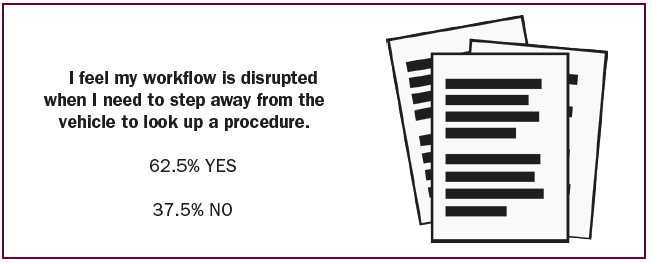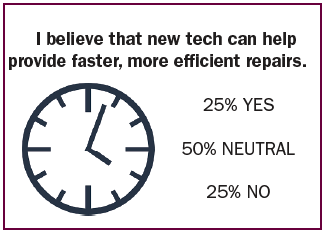CHANGE RESISTANCE
SOME BUSINESSES ARE SKEPTICAL OF HIGH-TECH TOOLS
The past few decades have transformed the tools used to conduct repairs.
Products such as ultraviolet lamps, which promise to reduce extensive paint drying times to fractional numbers, or diagnostic scanners that allow technicians to remotely dial in to receive assistance with repair procedures are no longer seen as gadgets offering trivial benefits, and widely accepted as requirements.
In general terms, though, many collision businesses are skeptical about any tools offering to revolutionize the way they do business. Only 25 percent respondents to a survey from Collision Repair agreed that high-tech products help in streamlining repairs.
Now, the one big equipment trend may be tools offering ‘at-your-fingertips’ access to repair procedure information—and repairer skepticism is again running high. There is a clear call for technology that reduces workflow interruptions—and more than 60 percent of respondents to a survey from Collision Repair said they feel their workflow is interrupted when they need to step away from the vehicle to look up a procedure.
Despite this, just half of the facility owners and managers surveyed by Collision Repair say they are interested in new products making information accessible from inside a vehicle’s hood. Part of the reason for this split may be psychological. As new tools come into play, workflow processes must be redesigned.
In the short term, this is as true about products designed to streamline repair procedures by allowing technicians to look up procedure guides remotely, as it would be for any new tool requiring workers to step away from the vehicle they are repairing.
Of course, the divide between collision figures interested in embracing the latest technology, and those who make more reserved purchasing decision may not be a clear case of right and wrong. While time may vindicate the earliest adopters of new OEM-procedures-at-your-fingertips devices, history does show that some promising equipment trends end up leading collision teams down expensive blind alleys.
As one repairer quipped: “Technology just changes too fast. Ask all the shops that bought the first water-based air dryers or aluminum repair equipment that are now obsolete.”

























